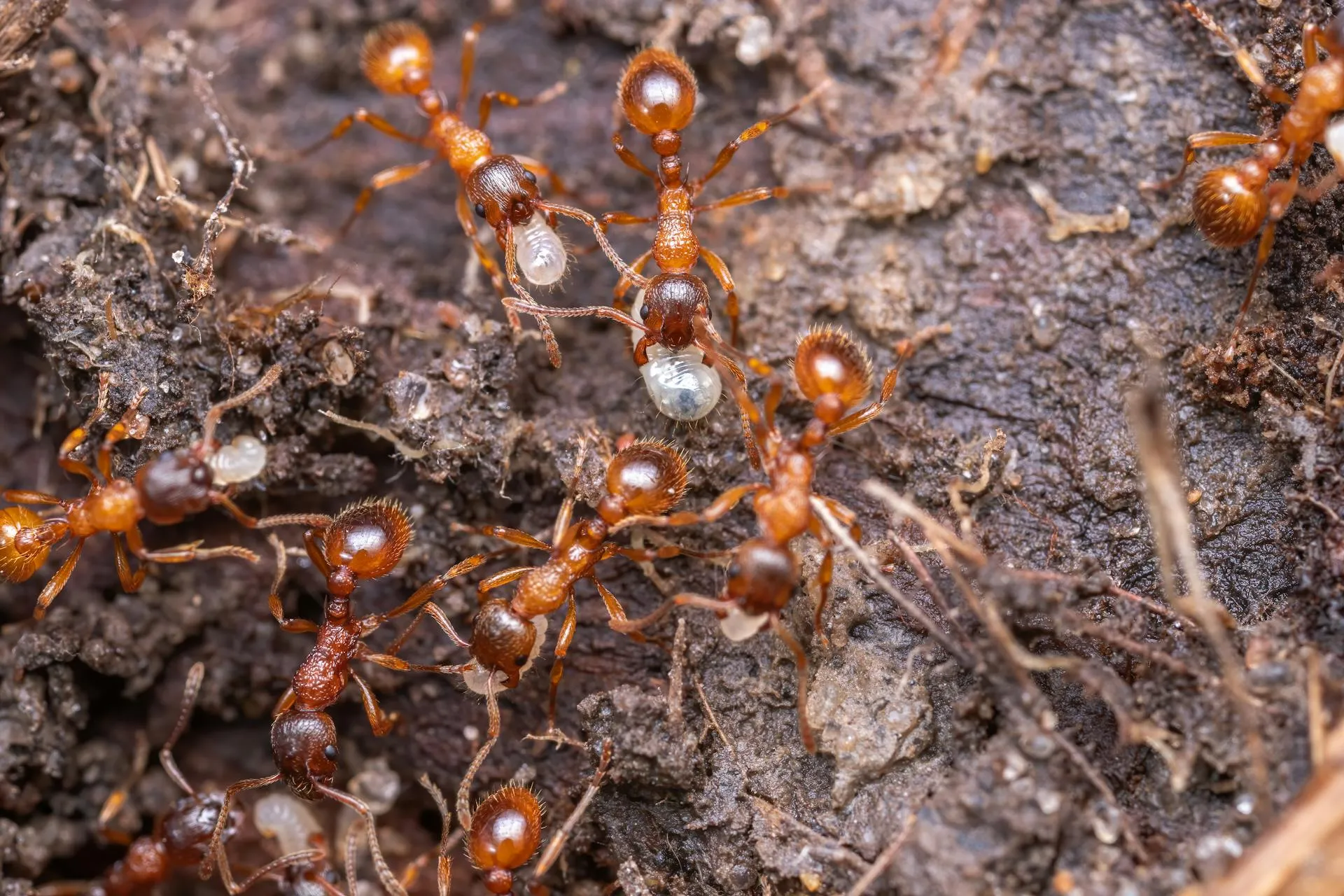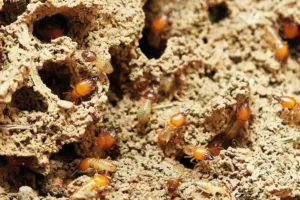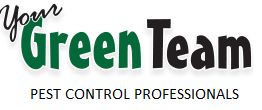
How Do You Get Rid of Termites Quickly?
Florida Termites Are a Serious Issue for Homeowners
Here’s the terrifying truth about termites: They’re just as stealthy as they are destructive. By the time you spot the telltale mud tubes and sawdust piles from these insects, they’ve likely been hurting your home for months (or even years).
So how do you get rid of termites permanently? Calling Your Green Team is key! If you have a small issue or a giant colony you’ve discovered, we’ll help you learn how to spot, stop, and prevent termites in Florida for good. Keep reading to learn more!
 How to Determine If You Have Termites
How to Determine If You Have Termites
Key Signs to Look For
Although they are difficult to locate, termites leave behind noticeable signs if you know where to look.
Mud tubes
Search for slender dirt tunnels on foundations or walls. These are used by termites to move from their nest to the wood in your house.
Discarded wings
After locating a new nesting location, flying termites shed their wings. These near windows are a sign of trouble.
Wood that’s hollow
Tape your baseboards or walls. Termites may be consuming the wood if they make an empty sound inside.
Termite excrement
Tiny wood-colored pellets that resemble sawdust piles are left behind by hardwood termites.
Sticking windows or doors
Doors and windows won’t open smoothly if termite damage causes the frames to warp.
Learn More About Four Kinds of Termites
Subterranean Termites
- Live underground
- Construct mud tubes to get to the wood
- Do the most harm in the United States
- Found everywhere but Alaska
- Worst in warm, humid places like Florida
Drywood Termites
- Live inside wood (no soil contact required)
- Leave droppings that resemble sawdust
- Prevalent in coastal states and arid regions
- Enter through furniture or exposed wood
Dampwood Termites
- Live in moist or decaying wood
- Found in the Pacific Northwest and humid zones like Florida
- Often in old stumps or leaky sheds
Formosan Termites
- Extremely aggressive
- Create massive colonies quickly.
- Primarily found in Southern states such as Texas and Louisiana
How Do You Get Rid of Termites?
DIY Termite Treatments (For Early/Minor Activity)
Termiticide foam
Termites are killed instantly when this foam expands to fill their tunnels. To apply it straight into mud tubes or infected wood, you’ll need a specialized injection kit. It only works for small, contained infestations and is most effective when you can see and access the damaged areas.
Bait stations
Termites carry the poisoned wood from these plastic traps back to their nest. Around the foundation of your house, place them 10–20 feet apart. Although they can eventually eradicate a colony, it takes several months for this method to fully work.
Barrier of liquid termiticide
When applied to the soil surrounding your foundation, it forms a chemical barrier that instantly kills termites. Additionally, it prevents them from getting moisture. For optimal protection, you must properly mix it and apply it evenly.
Nematodes
Termites are naturally killed by these microscopic worms. For a chemical-free alternative, release them in moist, infested areas. Although they aid in lowering termite populations, they are typically ineffective on their own and are best used in conjunction with other techniques to eradicate extensive infestations.
Orange oil and boric acid
Termites are poisoned when they consume boric acid, but they are killed when they come into contact with orange oil. Apply boric acid dust to exposed areas or apply orange oil to infected wood. Major infestations cannot be stopped by these, but they do work for minor issues.
Why Is DIY by Itself Typically Not Effective?
Termite colonies can contain thousands to millions of hidden members, depending on the number of nesting sites. DIY treatments typically ignore the main colony and only target surface-level activity.
Inappropriate application can spread termites, worsening the infestation. If you don’t use professional-grade products and techniques, you’re usually just treating the symptoms rather than fixing the problem.

What Are Some Professional Termite Treatments?
Professional Termite Inspection & Identification
Certified technicians use specialized tools like moisture meters and infrared cameras to identify termite species, locate nests, and assess damage. This crucial first step determines the best course of action for your unique situation, and many companies provide digital reports for clarity.
Termite Baiting Systems
From these isolated stations located throughout your property, worker termites transport contaminated cellulose back to their colony. Despite their slower-acting nature (taking months for complete elimination), bait systems—which often include continuous monitoring services—are effective against subterranean termites with minimal disturbance to the landscape.
Liquid Termiticide Barriers
Technicians dig a trench around your foundation and apply specialized insecticide to create an immediate barrier of protection. Modern formulas that use the “transfer effect” to spread poison throughout the colony typically provide several years of underground termite protection when used correctly.
Spot Treatments
To treat localized drywood termite infestations, professionals inject termiticide foam or dust directly into infested wood through tiny drilled holes. This minimally invasive technique kills termites on contact while leaving residual protection. It’s commonly used alongside monitoring for complete control.
Structure Fumigation (Tenting)
For severe drywood termite infestations, this intensive treatment is necessary, which involves sealing the building with tarps and releasing penetrating fumigant gas. It eliminates termites almost completely by getting to them deep within walls and structural wood. However, the homeowner will have to relocate temporarily.
Integrated Termite Management Plans
Depending on your home’s weaknesses, the best solutions combine multiple methods, including bait stations, wood repairs, and soil treatments. These all-inclusive programs often include annual inspections to prevent future infestations and ultimately save money on costly structural damage.
When to Call a Professional
Call an exterminator if you notice any of the following signs. Don’t wait! The longer termites exist in and around your home, the more expensive repairs can get.
Active swarmers (flying termites)
- Indicates the presence of an established colony nearby
- Suggests that the issue is already serious
Evident structural damage
- Drooping ceilings or floors
- Buckling wood
- Crumbling wallboard
- Indicates that the infestation has been present for months or years
DIY treatments that didn’t work
- Termites return
- Products from the store aren’t working well
- The colony is too large or uncooperative
Here’s why you should call a professional:
Special tools you can’t get
- Advanced bait systems (like Sentricon)
- Commercial-strength termiticides
Proper barrier treatments
- Protection for the entire perimeter
- Correct chemical application
Colony elimination
- Finds and destroys the main nest
- Stops future infestations from happening
How to Prevent Termites With Long-Term Solutions
Here are some of the most impactful termite prevention tips available that you can do yourself.
Control Any Moisture
- Repair leaks in faucets, roofs, and pipes right away.
- Improve the drainage around the foundation of your house by sloping the soil away from it.
- Gutter cleaning should be done frequently to avoid water accumulation.
- In moist crawl spaces and basements, use dehumidifiers.
- Make sure the attics and underfloors have adequate ventilation.
Limit Wood-to-Soil Contact
- Keep mulch, lumber, and firewood at least two inches from the foundation of your house.
- Use metal racks or concrete blocks instead of placing wood directly on the ground.
- Tree branches and shrubs should be trimmed to avoid touching the house.
- Use gravel or rubber substitutes in place of wood mulch close to foundations.
Seal Any Entry Points
- Examine exterior walls for loose siding, gaps around pipes, and foundation cracks.
- Use caulk or weatherstripping to seal the openings around windows, doors, and utility lines.
- Repair damaged roof shingles and vents to prevent moisture buildup.
Maintain Your Property
- Clear your yard of old wooden debris, dead trees, and stumps.
- Paper, cardboard, and other cellulose products should be kept in airtight plastic containers rather than on the ground.
- Compost piles should be kept away from homes.
Schedule Regular Inspections for Termites
- Once a year, or more frequently in high-risk areas, have a professional inspection.
- Look for mud tubes, frass, or hollow wood since early detection saves thousands on repairs.
Regional & Seasonal Considerations
Termites are most active during the spring and fall, when swarms are triggered by warm, humid weather. Preventing these peak seasons is best done in winter or late summer.
Your risk is influenced by where you live. Aggressive Formosan and subterranean termites spread quickly in the hot, humid South. Controlling moisture is essential because dampwood termites, which feed on water-damaged wood, are common in coastal and rainy regions.
Dry areas such as the Southwest are ideal for drywood termites. They don’t need to come into contact with soil to nest in wood and attics.
You can schedule inspections and treatments for optimal protection if you are aware of the risks in your area.
FAQs About Termite Control in Florida
Do termites bite humans?
Humans are not bitten by termites. They only eat wood and cellulose. Despite having strong jaws for gnawing through wood, they are not aggressive toward people or pets.
Is it possible to get rid of termites forever?
No treatment can ensure termites won’t return, but professional solutions (like liquid barriers and bait systems) can eliminate active colonies and provide long-term protection. Early detection of new infestations is facilitated by routine inspections.
What is the duration of termite treatment?
Fumigation (tenting) is a one-time treatment that doesn’t stop future infestations, bait stations need to be monitored and replaced frequently, liquid termiticides last for several years, and annual inspections help keep protection in place.
What draws termites to a house?
They might be attracted to a number of things: moisture (poor drainage, leaky pipes), wood-to-soil contact (wood, mulch, and deck posts touching the ground), foundation cracks, and cellulose materials (paper, cardboard, and wood debris close to the house).
What does a termite look like?
- Workers: Small (¼ inch), soft-bodied, creamy-white
- Swarmers (winged termites): Dark brown/black, ½ inch long, two equal-length wings
- Soldiers: Larger heads with pincers, pale yellow-brown
Conclusion
Professional assistance is crucial if you notice any structural damage, active swarmers, or mud tubes. The same is true if termite activity cannot be stopped by do-it-yourself methods. Because termites are always a threat to ruin your house.
Not sure how you get rid of termites permanently? Reach out to Your Green Team today! We proudly serve the greater Tampa area, ensuring high-quality lawn care and pest control services for these communities:
- Tampa, FL
- Sarasota, FL
- Bradenton, FL
- Brandon, FL
- Valrico, FL
- Land O’ Lakes, FL
- Ruskin, FL
- Riverview, FL
- Lithia, FL
- Fish Hawk, FL
- Parrish, FL
- Orlando, FL
